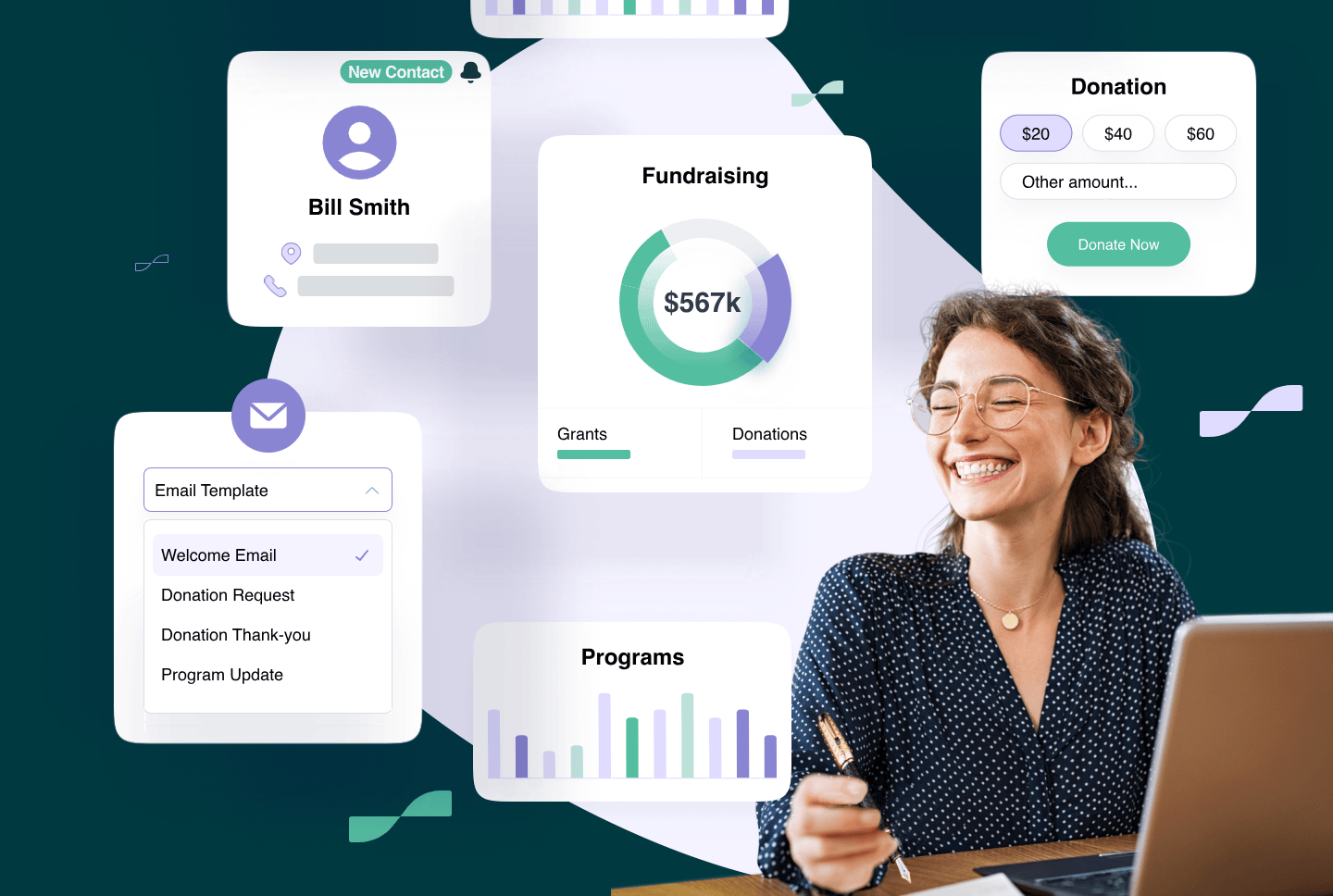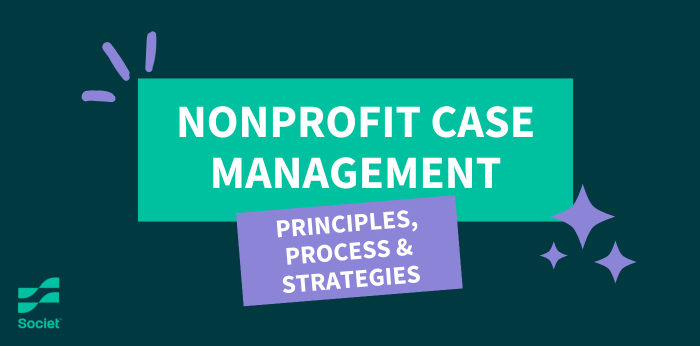
In this guide, you’ll find everything you need to know about nonprofit case management, including definitions, core principles, process steps, and best practices.
What is Case Management?
Case management is a structured, collaborative process used to assess, plan, coordinate, implement, monitor, and evaluate the services and supports required to meet a client’s health and human service needs.
It’s a personalized approach to care that places the client at the center of the process—focusing not only on solving immediate problems but also on building long-term self-sufficiency.
At its core, case management is about making sure individuals receive the right help, at the right time, from the right sources. Whether it’s navigating child and family services, housing systems, mental health services, substance use programs, job readiness training, or other support networks—Case management creates the bridge between their needs and the services that can fulfill them.
Key Elements of Case Management:
- Assessment: Identifying the client’s needs, strengths, and challenges.
- Planning: Developing a goal-based strategy to address those needs.
- Coordination: Connecting clients to services and resources.
- Monitoring: Tracking progress and adjusting plans as necessary.
- Advocacy: Ensuring clients receive equitable, timely support.
Nonprofit Case Management
Nonprofit case management, particularly in the realm of human and social services, involves the application of case management principles that support vulnerable or underserved populations.
These nonprofits often act as the connective tissue between individuals in crisis and a complex web of community resources, social programs, and government benefits.
- A food bank that helps clients access SNAP benefits and housing assistance
- A shelter that supports survivors of domestic violence with legal aid, therapy, and relocation services
- A community health center that coordinates mental health treatment alongside employment programs
What Are the 4 Levels of Case Management?
- Intensive Case Management
For high-need clients facing significant, multifaceted challenges requiring frequent, hands-on support. For example: chronic homelessness, severe mental illness, substance use disorders, domestic violence, or crisis situations. - Targeted Case Management
For medium-need clients with specific, time-bound goals—such as securing housing, completing a workforce program, or transitioning out of foster care. - Supportive Case Management
For clients who have basic stability but still benefit from occasional guidance, check-ins, referrals, and encouragement—such as seniors, single parents, or recently placed housing clients. - Self-Directed Case Management
For clients who are largely self-sufficient, but need occasional support to navigate systems, access resources, or verify eligibility (e.g., applying for benefits, finding job postings).
Knowing when to scale up or down across these levels is crucial for effective case management.
Case Management Process
To execute a successful case management strategy, understanding the case management process and breaking it down into practical, repeatable steps is essential.
Nonprofit Case Management Process Steps
Case management is not a one-size-fits-all endeavor. Each step builds upon the last to create a comprehensive, adaptable plan tailored to the unique needs of each client.
Below, we walk through each core step in detail, highlighting the purpose, key activities, and best practices.
- Step 1: Intake and Engagement
- Step 2: Needs Assessment
- Step 3: Risk evaluation
- Step 4: Service Planning
- Step 5: Service Delivery
- Step 6: Monitoring and Evaluation
- Step 7: Case Closure and Follow-Up
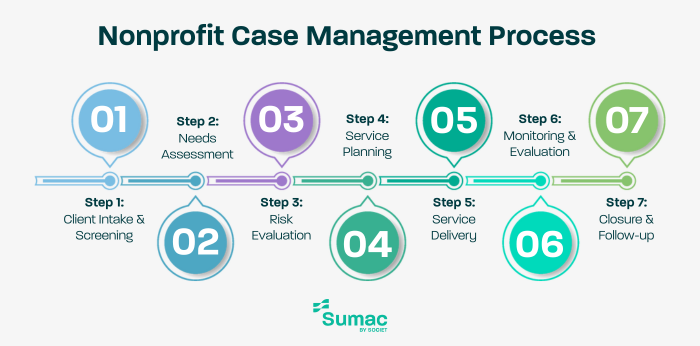
gmEach step in the nonprofit case management process requires precision, empathy, and documentation. Without the right tools, case managers may struggle with administrative overload, data silos, or incomplete records.
Sumac nonprofit case management software helps guide case managers through each step, enabling them to streamline client intake, assessments, planning, and reporting—while delivering the best client care.
Step 1: Intake and Screening: First Contact and Fit Assessment
What It Is:
Intake and screening mark the first formal interaction between a potential client and a case manager. It’s your opportunity to begin understanding who the client is, what they’re facing, and whether your organization is positioned to help.
- Collect client demographic data (name, DOB, contact details, etc.)
- Identify urgent needs (food insecurity, housing, safety)
- Record medical, psychological, and social history
- Begin rapport-building and clarify the purpose of case management
- Determine eligibility for services
Purpose:
To assess whether the client is a match for your organization’s programs and to initiate a trusting relationship. If not, the client should be referred to a more appropriate provider.
How to Level Up with Sumac:
Use Sumac’s web-based client intake forms to quickly capture all critical information and automatically create a digital client file. Intake data can feed directly into assessments and planning tools, eliminating double data entry and minimizing errors.
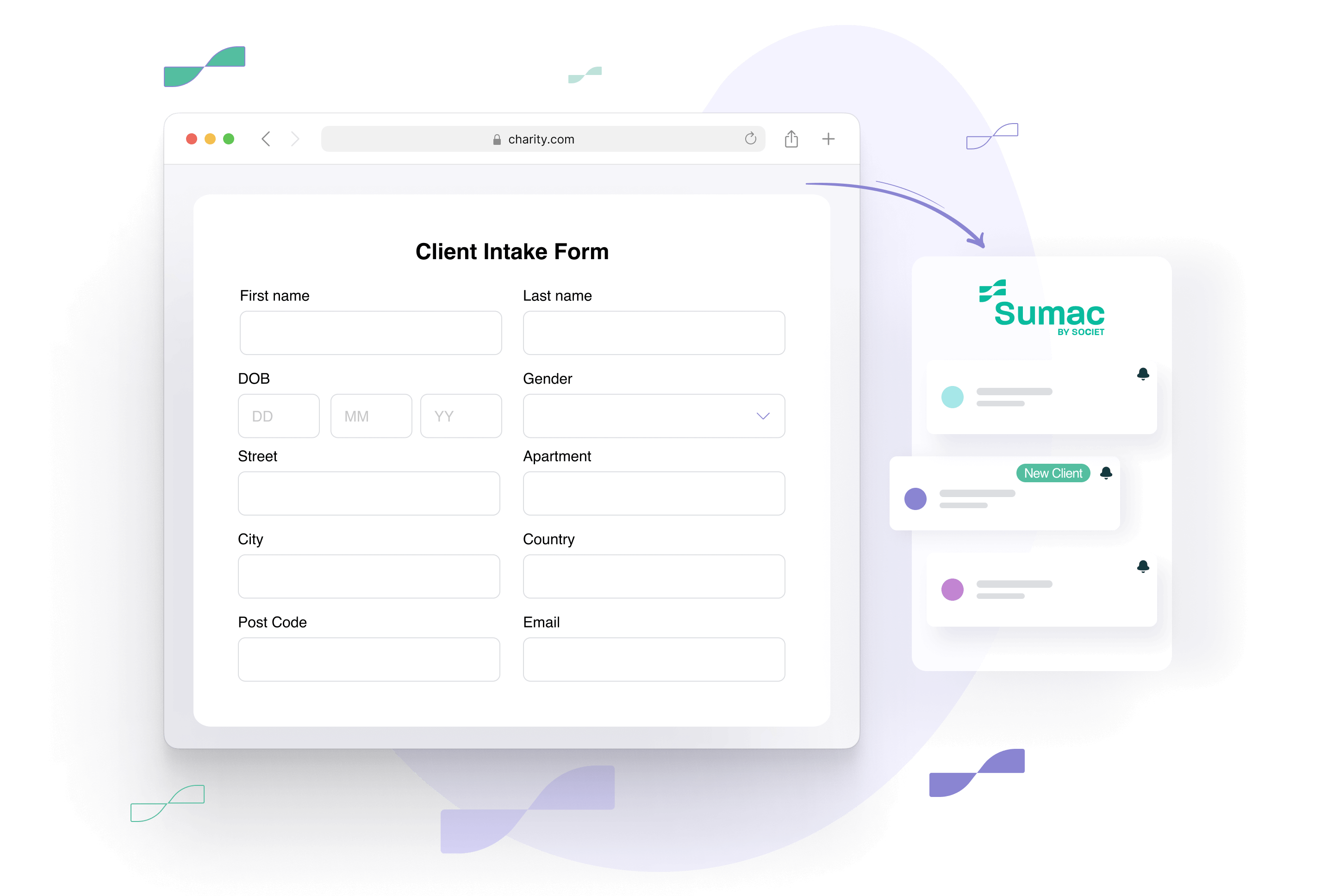
Step 2: Needs Assessment: Digging Deeper Into Client Challenges
What It Is:
This stage builds upon the intake by exploring a client’s deeper needs and identifying the root causes of their situation. A comprehensive case management needs assessment includes health, financial, environmental, and psychosocial factors.
- Conduct structured interviews or surveys
- Evaluate physical and emotional functioning
- Understand support systems (friends, family, institutions)
- Explore housing status, safety concerns, and transportation issues
- Review educational background and employment barriers
- Analyze legal history or involvement with other agencies
Purpose:
To create a well-rounded understanding of the client’s situation, prioritizing issues that need immediate attention versus long-term support.
How to Level Up with Sumac:
Build evidence-based needs assessments tailored to your programs in Sumac and include any kind of question you want, like housing status, income, mental health risks, or anything else you use to evaluate a client’s needs.
Step 3: Risk Evaluation: Prioritizing Based on Urgency and Complexity
What It Is:
Risk evaluation helps triage clients based on the severity of their needs. This ensures limited resources are allocated effectively and urgent cases receive appropriate attention quickly.
- Score or categorize risk (e.g., low, moderate, high)
- Identify red flags like suicidal ideation, abuse, or homelessness
- Determine the level of supervision or frequency of contact needed
- Flag for priority access to emergency or wraparound services
Purpose:
To align case management intensity with client risk level—ensuring that critical situations are escalated and properly managed.
How to Level Up with Sumac:
Flag high-risk cases in Sumac (for example: “Immediate Attention Needed” or “High Risk”) using custom fields and workflows. You can set reminders, or assign those cases to the appropriate team member, and log incidents with confidentiality and compliance in mind.
Step 4: Service Planning: Mapping the Road to Client Success
What It Is:
Once needs and risks are identified, the next step is to develop a detailed, collaborative nonprofit case management plan that outlines goals, services, and accountability measures.
- Set SMART goals (Specific, Measurable, Achievable, Relevant, Time-bound)
- Define services required (e.g., job training, therapy, childcare)
- Identify responsible parties for each task (client, case worker, partner orgs)
- Assign timelines and milestones for progress
- Get client input and buy-in
Purpose:
To move from assessment to action. A well-structured service plan provides a clear path to improved outcomes.
How to Level Up with Sumac:
Sumac makes service planning easy by letting you create personalized action plans for each client, with clearly defined steps, due dates, statuses (for example: “In Progress” or “Complete”), and team assignments.
These steps can be part of a broader case plan—such as attending counseling, submitting forms, or completing program milestones—and are visible directly in the client’s record and on staff dashboards. This allows your team to quickly track progress and stay aligned on each client’s journey.
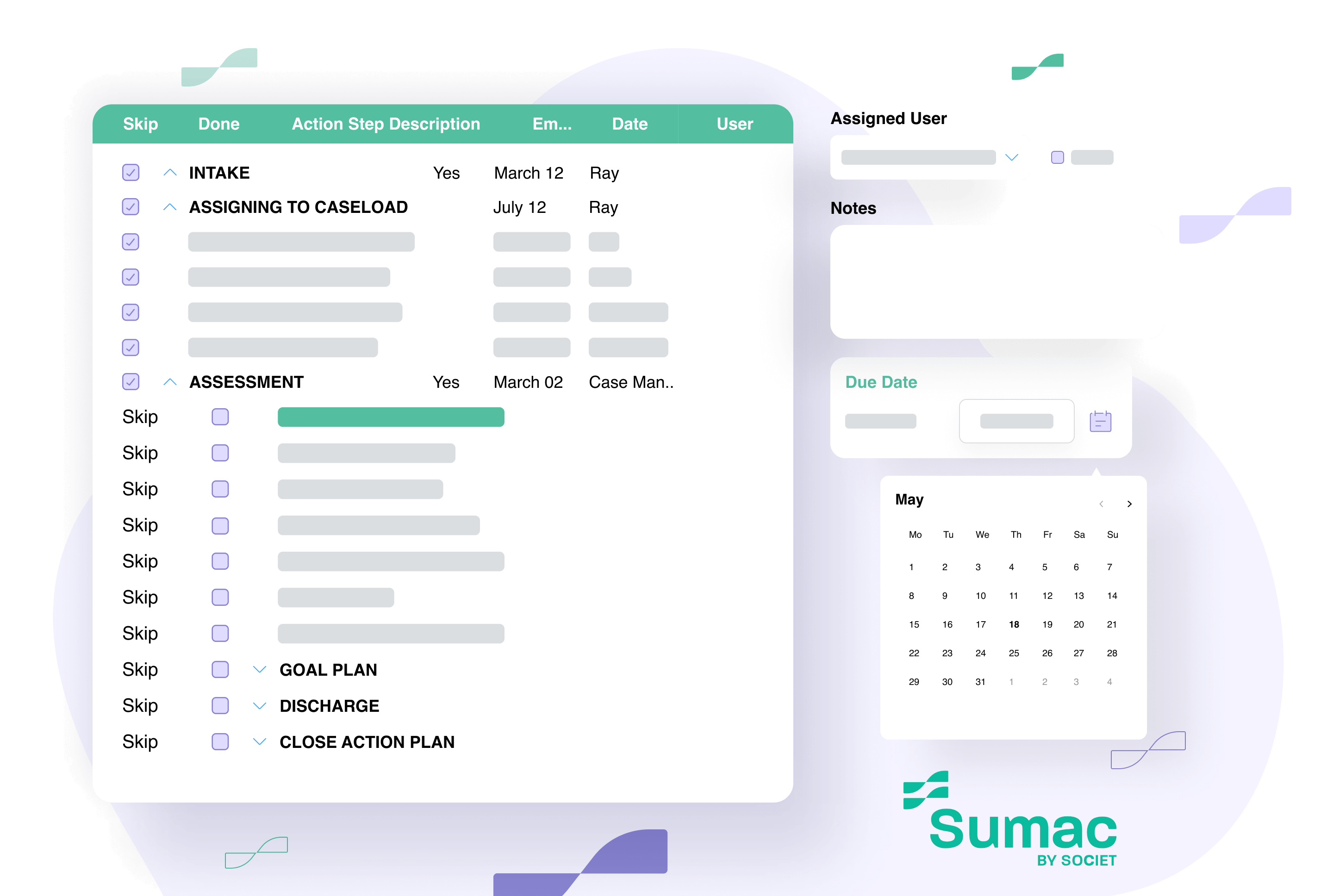
Step 5: Implementation and Coordination: Delivering the Plan
What It Is:
With the plan in place, it’s time to put it into action. This step involves coordinating services, following up with external providers, and keeping the client engaged.
- Connect the client with in-house or partner services
- Provide referrals and warm handoffs
- Manage schedules and appointments
- Navigate external systems (e.g., insurance, housing authorities)
- Address logistical or transportation barriers
- Maintain client motivation and participation
Purpose:
To ensure the plan translates into real services and that the client receives the support they need efficiently and holistically.
How to Level Up with Sumac:
Sumac allows you to coordinate efforts across departments and external agencies. Case managers can use Sumac Case Portal to manage clients, case notes, and meetings on the go—all from a centralized dashboard.
Step 6: Monitoring and Evaluation: Tracking Progress and Adapting
What It Is:
This is an ongoing process of reviewing the client’s progress toward their goals and adjusting the plan as necessary.
- Monitor service usage and completion
- Measure outcomes using predefined metrics (e.g., employment secured, housing obtained)
- Document setbacks or changes in circumstance
- Reassess risk and needs periodically
- Adjust goals and services as required
Purpose:
To stay agile and responsive. Monitoring ensures clients are making progress, and evaluations help case managers and stakeholders understand what’s working (and what isn’t).
How to Level Up with Sumac:
Use Sumac’s real-time reporting tools to track client progress at both individual and program levels. Export outcome data for grant reports or board meetings, and set automated reminders for scheduled reassessments or goal check-ins.
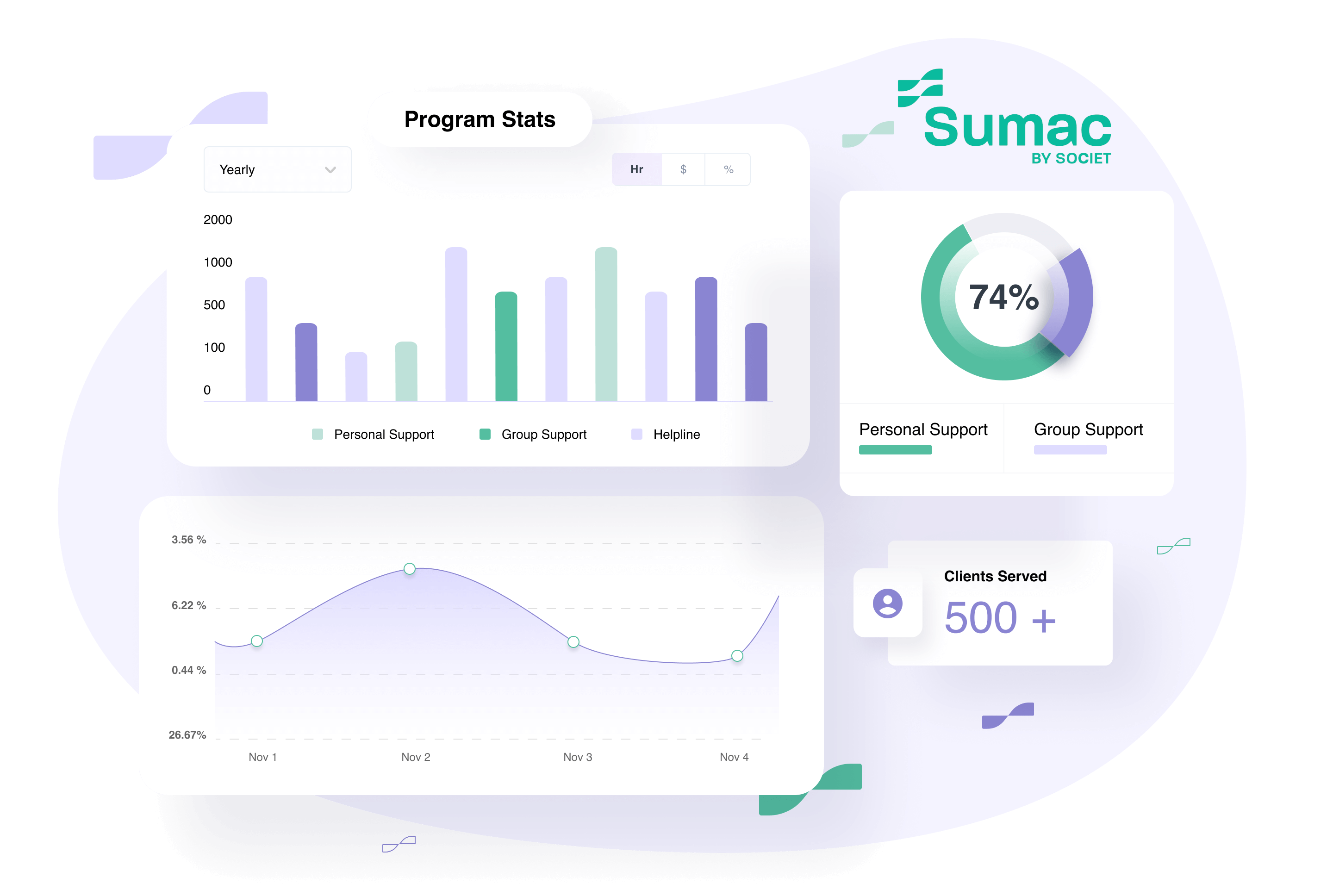
Step 7: Case Closure and Follow-Up: Ending or Transitioning the Relationship
What It Is:
When the client has achieved their goals or no longer needs services, the case is formally closed. However, many organizations also include follow-up as part of their best practices to ensure long-term success.
- Review all goals and note which were met
- Solicit client feedback through exit interviews or surveys
- Provide final referrals or resources
- Document case closure status and reason
- Schedule post-case check-ins if needed
Purpose:
To ensure clients leave your services better equipped and with clarity about their progress and next steps. Closure also allows case managers to evaluate program efficacy and workload balance.
How to Level Up with Sumac:
Sumac enables smooth transitions by archiving client records while keeping them accessible for future follow-up. Generate closure reports and client outcome summaries in just a few clicks.
Nonprofit Case Management Principles
Balancing Practice Values with Industry Standards
Effective case management is grounded in both everyday human-centered values and formalized industry principles.
Whether you’re serving clients experiencing homelessness, coordinating health and social services, or helping families access education and housing, these principles guide ethical and impactful casework.
Practice-Based Values That Guide Nonprofit Case Management
Many nonprofit professionals—especially those in community services—embrace values that align with the real-world dynamics of serving people in crisis. These values are rooted in respect, responsiveness, and care coordination:
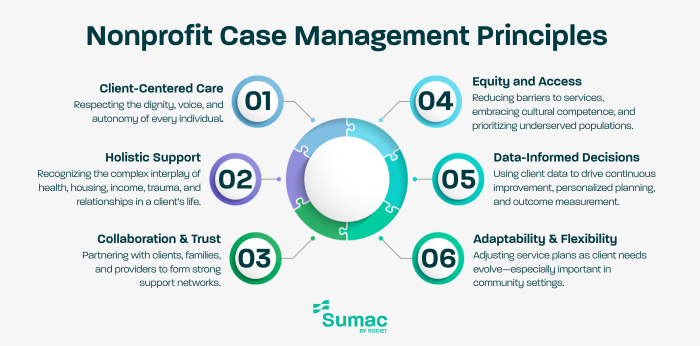
- Client-Centered Care
Respecting the dignity, voice, and autonomy of every individual. - Holistic Support
Recognizing the complex interplay of health, housing, income, trauma, and relationships in a client’s life. - Collaboration & Trust-Building
Partnering with clients, families, and providers to form strong support networks. - Equity and Access
Reducing barriers to services, embracing cultural competence, and prioritizing underserved populations. - Data-Informed Decision Making
Using client data to drive continuous improvement, personalized planning, and outcome measurement. - Adaptability and Flexibility
Adjusting service plans as client needs evolve—especially important in community settings.
These values ensure the case management process remains dynamic, responsive, and compassionate—especially when dealing with complex or high-risk cases.
Formal Principles from CMSA and Industry Standards
To reinforce your approach with professional integrity, it’s helpful to also acknowledge formal definitions used across sectors like health care, mental health, and licensed social work.
The Case Management Society of America (CMSA) defines core standards in its Standards of Practice for Case Management. These principles include:
- Client Advocacy
Promoting autonomy, informed decision-making, and protection of client rights. - Professional Integrity
Adhering to ethical conduct, confidentiality, and role boundaries. - Cultural Competency
Delivering inclusive services that respect each client’s background and identity. - Evidence-Based Practice
Applying current research and best practices in planning and intervention. - Health and Human Service Integration
Coordinating across systems to provide seamless, quality care.
You can view the full list of CMSA principles here.
How to Bring These Principles to Life With Technology
Regardless of the framework you follow, one thing is clear: operationalizing case management principles requires tools that match your intent.
That’s where Sumac nonprofit case management software shines. Sumac helps your organization:
- Centralize client data and service history
- Build collaborative case plans that reflect client voice and values
- Securely coordinate between staff, programs, and external partners
- Track equity and access metrics over time
- Report on outcomes that align with funder expectations and professional standards
By combining the relational heart of nonprofit casework with recognized professional standards, your organization can provide care that is both compassionate and credible.
Lean on values to guide your daily decisions—and lean on standards to demonstrate your quality and consistency to partners, funders, and accrediting bodies.
Nonprofit Case Management Best Practices
Case management for nonprofits is not just about client welfare—it’s also about accountability to funders, regulatory compliance, and team efficiency. To ensure maximum impact and accountability, nonprofits should embrace these case management best practices:
1. Use a Centralized CRM System
- Store all client records securely
- Track services and progress over time
- Generate reports for funders
- Share data across teams in real-time
2. Standardize Intake and Assessment
Implement consistent tools for client intake, case management assessment and case management needs assessment to eliminate bias and ensure accurate eligibility decisions.
3. Develop SMART Goals
Every nonprofit case management plan should contain SMART (Specific, Measurable, Achievable, Relevant, Time-bound) goals, making it easier to track success.
4. Prioritize Communication
Strong communication builds rapport and trust. Use secure messaging tools and conduct regular check-ins to ensure clients stay engaged.
5. Monitor and Adapt
Effective case management requires continual evaluation. Use outcome data to improve services and adapt plans when necessary.
Case Management Strategies
Driving Better Outcomes in Nonprofit Human Services
Successful nonprofit case management goes beyond following a process—it requires using proactive strategies and case management models that respond to clients’ evolving needs, organizational goals, and systemic challenges.
Here are five powerful case management strategies your nonprofit can adopt to increase impact and efficiency:
1. Client Empowerment
- Motivational interviewing to uncover intrinsic goals
- Co-creating plans that reflect client priorities
- Teaching life skills and resource navigation
- Offering choices rather than directives
2. Service Mapping
- Keeping a live directory of local agencies, eligibility rules, and contact persons
- Building relationships with partner organizations
- Creating referral workflows that ensure follow-through
- Identifying service gaps that affect client outcomes
3. Data-Driven Decision Making
- Tracking goal completion and service utilization
- Analyzing trends across programs or populations
- Using dashboards to monitor outcomes in real-time
- Making program adjustments based on performance metrics
4. Holistic, Integrated Care
Clients rarely face a single issue. Successful case management must consider the whole person, including physical health, mental health, housing, income, relationships, and cultural factors. A holistic strategy involves:
- Using comprehensive assessments that span multiple life domains
- Coordinating with specialists (mental health, employment, legal aid, etc.)
- Recognizing trauma, stigma, and barriers to care
- Supporting both short-term relief and long-term resilience
5. Technology Integration
Paper files and siloed spreadsheets slow down even the best case managers. A modern, cloud-based CRM like Sumac social work case management software helps organizations:
- Streamline workflows for intake, assessments, and planning
- Share data securely across teams and departments
- Coordinate services in real-time
- Automate routine tasks like reminders and reporting
By combining these nonprofit case management strategies—client empowerment, service mapping, data analysis, holistic care, and smart technology—your nonprofit can deliver more effective, personalized, and scalable wraparound services that change lives.
Conclusion
Nonprofit case management is more than a series of tasks—it’s a philosophy grounded in dignity, empowerment, and collaboration. By embracing the case management principles and following a well-defined case management process, organizations can truly change lives.
With the right strategies, tools, and technology—like Sumac—your organization can streamline case management, deliver better outcomes, and operate more effectively.




